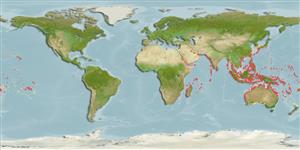>
Ovalentaria/misc (Various families in series Ovalentaria) >
Pomacentridae (Damselfishes) > Glyphisodontinae
Etymology: Abudefduf: Arabic, abu = father; this fish is the leader of the reef against other species (Ref. 45335).
More on authors: Quoy & Gaimard.
Environment: milieu / climate zone / depth range / distribution range
экология
морской ассоциированный с рифами; мигрирует в океане (Ref. 51243); пределы глубины 0 - 15 m (Ref. 30874). Tropical; 36°N - 39°S, 26°E - 143°W
Indo-Pacific: Red Sea and eastern Africa to the Line and Tuamoto islands, north to southern Japan, south to Australia. Recorded in Bay of Islands, New Zealand (Ref. 35942). Often confused with the closely related Atlantic species Abudefduf saxatilis (Ref. 7247).
Length at first maturity / Size / Вес / Возраст
Maturity: Lm 12.0 range ? - ? cm
Max length : 20.0 cm TL самец/пол неопределен; (Ref. 4391)
Краткое описание
определительные ключи | морфология | морфометрия
колючие лучи спинного плавника (общее число) : 13; членистые (мягкие) лучи спинного плавника (общее число) : 12 - 14; колючие лучи анального плавника: 2; членистые (мягкие) лучи анального плавника: 11 - 13. This species is characterized by having the following features: body depth 1.5-1.8 in SL; forked caudal fin; colour of body blue-green dorsally, shading to silvery white ventrally; five broad bluish black bars the first just behind the head, the narrow fifth on caudal peduncle, the third to fifth extending into the dorsal fin; dorsal part of body between the first and third dark bars often yellow (yellowish hue on anterodorsal part of the body apparent especially during courtship and nesting); caudal fin without dark bands (Ref. 11441, 90102).
Adults inhabit upper edge of outer reef slopes and inshore rocky reefs. Juveniles associated with drifting seaweed (Ref. 12114, 12115). Benthopelagic (Ref. 58302). Feed on zooplankton, benthic algae, and small invertebrates (Ref. 1602). Often in aggregations (Ref. 9710) feeding at midwater or tending nests among rocks and coral ledges (Ref. 90102). In large numbers at spawning sites that are timed with large tides that carry their pelagic offspring far offshore (Ref. 48636). Oviparous, distinct pairing during breeding (Ref. 205). Eggs are demersal and adhere to the substrate (Ref. 205). Males guard and aerate the eggs (Ref. 205). Minimum depth reported taken from Ref. 128797.
Oviparous, distinct pairing during breeding (Ref. 205). Eggs are demersal and adhere to the substrate (Ref. 205). Males guard and aerate the eggs (Ref. 205).
Allen, G.R., 1991. Damselfishes of the world. Mergus Publishers, Melle, Germany. 271 p. (Ref. 7247)
Статус Красного Списка МСОП (Ref. 130435: Version 2024-2)
Угроза для людей
Reports of ciguatera poisoning (Ref. 30303)
Использование человеком
рыболовство: рыболовство как средство для существования; аквариум: коммерческий
дополнительная информация
инструменты
Специальные отчеты
Скачать в формате XML
ресурсы в Интернет
Estimates based on models
Preferred temperature (Ref.
123201): 21.9 - 29.3, mean 28.2 °C (based on 3494 cells).
Phylogenetic diversity index (Ref.
82804): PD
50 = 0.5000 [Uniqueness, from 0.5 = low to 2.0 = high].
Bayesian length-weight: a=0.02455 (0.01409 - 0.04276), b=3.07 (2.92 - 3.22), in cm total length, based on LWR estimates for this species & Genus-body shape (Ref.
93245).
Trophic level (Ref.
69278): 2.6 ±0.4 se; based on diet studies.
Generation time: 1.3 ( na - na) years. Estimated as median ln(3)/K based on 1
growth studies.
устойчивость к внешним воздействиям (Ref.
120179): высокий, минимальное время удвоения популяции до 15 месяцев (K=0.85).
Prior r = 1.20, 95% CL = 0.79 - 1.80, Based on 1 data-limited stock assessment.
Fishing Vulnerability (Ref.
59153): Low vulnerability (16 of 100).
Nutrients (Ref.
124155): Calcium = 96 [50, 151] mg/100g; Iron = 0.795 [0.479, 1.283] mg/100g; Protein = 18.5 [17.3, 19.6] %; Omega3 = 0.0986 [, ] g/100g; Selenium = 28.3 [15.8, 53.3] μg/100g; VitaminA = 45.1 [12.6, 153.4] μg/100g; Zinc = 1.55 [1.06, 2.23] mg/100g (wet weight);
